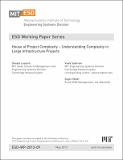| dc.description.abstract | This paper describes our conceptualization of complexity in Large Infrastructure Projects (LIPs). Since complexity itself is an emergent concept that is hard to pin down, we focus on the relationship between various project features and, particularly, properties associated with complexity such as difficulty, outcome variability and non-linearity, and (non) governability. We propose a combined structural and process-based theoretical framework for understanding contributors to complexity in this particular substantive context – the “House of Project Complexity” (HoPC). The HoPC addresses the impact of inherent technical and institutional project features, the process of project architecting, the structural relationship between various project features and these “designed” constructs, and the emergence of risks and life-cycle properties (‘ilities’). The HoPC is first applied to two trial samples and then to the main data set of detailed case studies of infrastructure projects prepared for the IMEC study. We believe that the “House of Project Complexity” can be generally extended to other substantive contexts that exhibit similar properties as Large Infrastructure Projects (LIPs), in the extractive industries, large manufacturing projects, or other industrial megaprojects. | en_US |
